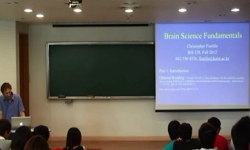Purpose : To evaluate CT and MR findings of the intracranial schwannomas arising from variable cranial nerves. Materials and Methods : The authors retrospectively analyzed CT (n=21) and MR(n=15) findings of 24 cases in 23 patients(M : 7, F : 16) who ...
http://chineseinput.net/에서 pinyin(병음)방식으로 중국어를 변환할 수 있습니다.
변환된 중국어를 복사하여 사용하시면 됩니다.
- 中文 을 입력하시려면 zhongwen을 입력하시고 space를누르시면됩니다.
- 北京 을 입력하시려면 beijing을 입력하시고 space를 누르시면 됩니다.
https://www.riss.kr/link?id=A100882853
- 저자
- 발행기관
- 학술지명
- 권호사항
-
발행연도
1996
-
작성언어
Korean
- 주제어
-
등재정보
KCI등재,SCOPUS
-
자료형태
학술저널
- 발행기관 URL
-
수록면
443-450(8쪽)
- 제공처
- 소장기관
-
0
상세조회 -
0
다운로드
부가정보
다국어 초록 (Multilingual Abstract)
Purpose : To evaluate CT and MR findings of the intracranial schwannomas arising from variable cranial nerves. Materials and Methods : The authors retrospectively analyzed CT (n=21) and MR(n=15) findings of 24 cases in 23 patients(M : 7, F : 16) who had suffered from surgically-proven intracranial schwannomas over the previous five years. Results : Schwannomas arose from the acoustic nerve(n=18), the trigeminal nerve(n=2), the glossopha-ryngeal-vagal-accessory nerve complex (n=2), and the olfactory nerve(n=1). Intracranial schwannomas were well defined, lobulated and inhomogeneously or homogeneously enhancing masses on CT and MR, and were located along the course of the specific cranial nerve. Acoustic schwannomas involved both the internal auditory canal(IAC) and the cerebellopontine angle(CPA) in 14 cases, the IAC in three, and the CPA in two. Two trigeminal schwannomas involved both middle and posterior cranial fossa and were in the shape of a dumbbell. One of the two schwannomas that invelved lower cranial nerve complex(9-11th) was located in the medullary cistern and jugular foramen ; the other was located in the central posterior cranial fossa. A case of olfactory schwannoma was located in the right cribriform plate. The precontrast CT scan showed low density in 13 cases(62%), isodensity in seven(33%) and high density in one(5%). On postcontrast CT scan, enhancement was seen in 20 cases(95%). Of the 15 cases with MR, 12 had low signal intensity on T1 weighted image and 14 had high signal intensity on T2 weighted image. MR imaging after Gd-DTPA infusion showed enhancement in 14 cases. Enhancement was inhomogeneous in 14 cases on CT and in 13 on MR. Of 24 cases, intratumoral necrosis was seen in 19, ring enhancement in five and severe cystic change in one. Other findings were intratumoral calcification(21%), hemorrhage(8%), pressure bony erosion(70.8%), midline shift(58%), peritumoral edema(29%) and hydrocephalus(33%). On MR, there was in all 15 cases a peritumoral low signal intensity rim on T1- and T2- weighted images and on a T1 weighted image following gadolium infusion. A case of olfactory groove schwannoma was associated with neurofibromatosis type I and a case of bilateral acoustic schwannoma with neurofibromatosis II. Conclusion : Schwannomas can be easily diagnosed when a well defined, lobulated and inhomogeneously enhancing mass with intratumoral necrosis, cystic change, calcification or hemorrhage is seen along the course of a cranial nerve. Peritumoral low signal intensity rim on MR may be helpful in differentiating intracranial schwannomas from other tumors.
동일학술지(권/호) 다른 논문
-
- 대한영상의학회
- 김형석
- 1996
- KCI등재,SCOPUS
-
요추추간판 탈출증의 자기공명영상: 탈출 방향과 신경근 및 경막낭의 압박소견과의 관계
- 대한영상의학회
- 차병훈
- 1996
- KCI등재,SCOPUS
-
악성 및 양성 갑상선 종양의 감별에 있어서의 CT 소견
- 대한영상의학회
- 정혜원
- 1996
- KCI등재,SCOPUS
-
- 대한영상의학회
- 김규선
- 1996
- KCI등재,SCOPUS






 ScienceON
ScienceON






